Steel is made by the Bessemer, Siemens Open Hearth, basic oxygen furnace, electric arc, electric high-frequency and crucible processes.
Crucible and high-frequency methods
The Huntsman crucible process has been superseded by the high
frequency induction furnace in which the heat is generated in the
metal itself by eddy currents induced by a magnetic field set up by
an alternating current, which passes round water-cooled coils
surrounding the crucible. The eddy currents increase with the square
of the frequency, and an input current which alternates from 500 to
2000 hertz is necessary. As the frequency increases, the eddy
currents tend to travel nearer and nearer the surface of a charge
(i.e. shallow penetration). The heat developed in the charge depends
on the cross-sectional area which carries current, and large
furnaces use frequencies low enough to get adequate current
penetration.
Automatic circulation of the melt in a vertical direction, due to
eddy currents, promotes uniformity of analysis. Contamination by
furnace gases is obviated and charges from 1 to 5 tonnes can be
melted with resultant economy. Consequently, these electric furnaces
are being used to produce high quality steels, such as ball bearing,
stainless, magnet, die and tool steels.
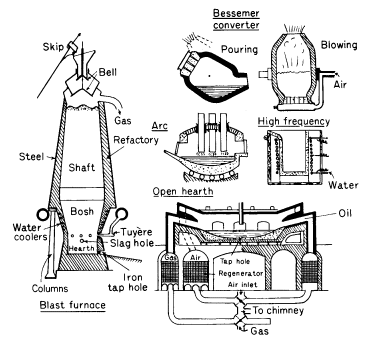 |
|
Figure 1.
Furnaces used for making pig iron and steels. RH side of open hearth furnace shows use of oil instead of gas
|
Acid and basic steels
The remaining methods for making steel do so by removing
impurities from pig iron or a mixture of pig iron and steel scrap.
The impurities removed, however, depend on whether an acid
(siliceous) or basic (limey) slag is used. An acid slag necessitates
the use of an acid furnace lining (silica); a basic slag, a basic
lining of magnesite or dolomite, with line in the charge. With an
acid slag silicon, manganese and carbon only are removed by
oxidation, consequently the raw material must not contain phosphorus
and sulphur in amounts exceeding those permissible in the finished
steel.
In the basic processes, silicon, manganese, carbon, phosphorus
and sulphur can be removed from the charge, but normally the raw
material contains low silicon and high phosphorus contents. To
remove the phosphorus the bath of metal must be oxidised to a
greater extent than in the corresponding acid process, and the final
quality of the steel depends very largely on the degree of this
oxidation, before deoxidisers-ferro-manganese, ferro-silicon,
aluminium-remove the soluble iron oxide and form other insoluble
oxides, which produce non-metallic inclusions if they are not
removed from the melt:
2Al + 3FeO (soluble) « 3Fe + Al2O3
(solid)
In the acid processes, deoxidation can take place in the
furnaces, leaving a reasonable time for the inclusions to rise into
the slag and so be removed before casting. Whereas in the basic
furnaces, deoxidation is rarely carried out in the presence of the
slag, otherwise phosphorus would return to the metal. Deoxidation of
the metal frequently takes place in the ladle, leaving only a short
time for the deoxidation products to be removed. For these reasons
acid steel is considered better than basic for certain purposes,
such as large forging ingots and ball bearing steel. The
introduction of vacuum degassing hastened the decline of the acid
processes.
Bessemer steel
In both the Acid Bessemer and Basic Bessemer (or Thomas)
processes molten pig iron is refined by blowing air through it in an
egg-shaped vessel, known as a converter, of 15-25 tonnes capacity
(Fig. 1). The oxidation of the impurities raises the charge to a
suitable temperature; which is therefore dependent on the
composition of the raw material for its heat: 2% silicon in the acid
and 1,5-2% phosphorus in the basic process is normally necessary to
supply the heat. The "blowing" of the charge, which causes an
intense flame at the mouth of the converter, takes about 25 minutes
and such a short interval makes exact control of the process a
little difficult.
The Acid Bessemer suffered a decline in favour of the
Acid Open Hearth steel process, mainly due to economic factors which
in turn has been ousted by the basic electric arc furnace coupled
with vacuum degassing.
The Basic Bessemer process is used a great deal on the
Continent for making, from a very suitable pig iron, a cheap class
of steel, e.g. ship plates, structural sections. For making steel
castings a modification known as a Tropenas converter is used, in
which the air impinges on the surface of the metal from side tuyeres
instead of from the bottom. The raw material is usually melted in a
cupola and weighed amounts charged into the converter.
Open-hearth processes
In the Siemens process, both acid and basic, the necessary heat
for melting and working the charge is supplied by oil or gas. But
the gas and air are preheated by regenerators, two on each side of
the furnace, alternatively heated by the waste gases. The
regenerators are chambers filled with checker brickwork, brick and
space alternating.
The furnaces have a saucer-like hearth, with a capacity which
varies from 600 tonnes for fixed, to 200 tonnes for tilting furnaces
(Fig. 1). The raw materials consist essentially of pig iron (cold or
molten) and scrap, together with lime in the basic process. To
promote the oxidation of the impurities iron ore is charged into the
melt although increasing use is being made of oxygen lancing. The
time for working a charge varies from about 6 to 14 hours, and
control is therefore much easier than in the case of the Bessemer
process.
The Basic Open Hearth process was used for the bulk of the
cheaper grades of steel, but there is a growing tendency to replace
the OH furnace by large arc furnaces using a single slag process
especially for melting scrap and coupled with vacuum degassing in
some cases.
Electric arc process
The heat required in this process is generated by electric arcs
struck between carbon electrodes and the metal bath (Fig. 1).
Usually, a charge of graded steel scrap is melted under an oxidising
basic slag to remove the phosphorus. The impure slag is removed by
tilting the furnace. A second limey slag is used to remove sulphur
and to deoxidise the metal in the furnace. This results in a high
degree of purification and high quality steel can be made, so long
as gas absorption due to excessively high temperatures is avoided.
This process is used extensively for making highly alloyed steel
such as stainless, heat-resisting and high-speed steels.
Oxygen lancing is often used for removing carbon in the presence
of chromium and enables scrap stainless steel to be used. The
nitrogen content of steels made by the Bessemer and electric arc
processes is about 0,01-0,25% compared with about 0,002-0,008% in
open hearth steels.
Oxygen processes
The high nitrogen content of Bessemer steel is a
disadvantage for certain cold forming applications and continental
works have, in recent years, developed modified processes in which
oxygen replaces air. In Austria the LID process (Linz-Donawitz)
converts low phosphorus pig iron into steel by top blowing with an
oxygen lance using a basic lined vessel (Fig. 2b). To avoid
excessive heat scrap or ore is added. High quality steel is produced
with low hydrogen and nitrogen (0,002%). A further modification of
the process is to add lime powder to the oxygen jet (OLP process)
when higher phosphorus pig is used.
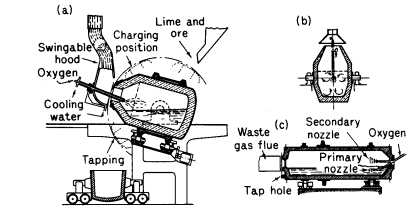 |
|
Figure 2. |
The Kaldo (Swedish) process uses top blowing with oxygen
together with a basic lined rotating (30 rev/min) furnace to get
efficient mixing (Fig. 2a). The use of oxygen allows the
simultaneous removal of carbon and phosphorus from the (P, 1,85%)
pig iron. Lime and ore are added. The German Rotor process
uses a rotary furnace with two oxygen nozzles, one in the metal and
one above it (Fig. 2c). The use of oxygen with steam (to reduce the
temperature) in the traditional basic Bessemer process is also now
widely used to produce low nitrogen steel. These new techniques
produce steel with low percentages of N, S, P, which are quite
competitive with open hearth quality.
Other processes which are developing are the Fuel-oxygen-scrap,
FOS process, and spray steelmaking which consists in pouring iron
through a ring, the periphery of which is provided with jets through
which oxygen and fluxes are blown in such a way as to "atomise" the
iron, the large surface to mass ratio provided in this way giving
extremely rapid chemical refining and conversion to steel.
Vacuum degassing is also gaining ground for special
alloys. Some 14 processes can be grouped as stream, ladle, mould and
circulation (e.g. DH and RH) degassing methods, Fig. 3. The vacuum
largely removes hydrogen, atmospheric and volatile impurities (Sn,
Cu, Pb, Sb), reduces metal oxides by the C – O reaction and
eliminates the oxides from normal deoxidisers and allows control of
alloy composition to close limits. The clean metal produced is of a
consistent high quality, with good properties in the transverse
direction of rolled products. Bearing steels have greatly improved
fatigue life and stainless steels can be made to lower carbon
contents.
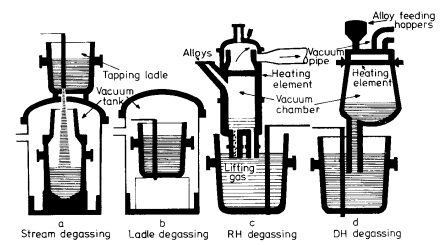 |
|
Figure 3. Methods of degassing molten steel
|
Vacuum melting and ESR. The aircraft designer has
continually called for new alloy steels of greater uniformity and
reproducibility of properties with lower oxygen and sulphur
contents. Complex alloy steels have a greater tendency to
macro-segregation, and considerable difficulty exists in minimising
the non-metallic inclusions and in accurately controlling the
analysis of reactive elements such as Ti, Al, B. This problem led to
the use of three processes of melting.
(a) Vacuum induction melting within a tank for producing super
alloys (Ni and Co base), in some cases for further remelting for
investment casting. Pure materials are used and volatile tramp
elements can be removed.
(b) Consumable electrode vacuum arc
re-melting process (Fig. 4) originally used for titanium, was found
to eliminate hydrogen, the A and V segregates and also the large
silicate inclusions. This is due to the mode of solidification. The
moving parts in aircraft engines are made by this process, due to
the need for high strength cleanness, uniformity of properties,
toughness and freedom from hydrogen and tramp elements.
(c)
Electroslag refining (ESR) This process, which is a larger form of
the original welding process, re-melts a preformed electrode of
alloy into a water-cooled crucible, utilising the electrical
resistance heating in a molten slag pool for the heat source (Fig.
5). The layer of slag around the ingot maintains vertical
unidirectional freezing from the base. Tramp elements are not
removed and lead may be picked up from the slag.
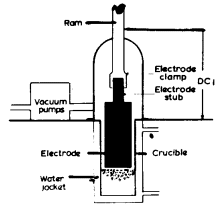 |
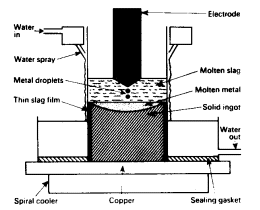 |
|
Figure 4.
Typical vacuum arc remelting furnace |
Figure 5.
Electroslag remelting furnace
|
List of Articles - Knowledge Base